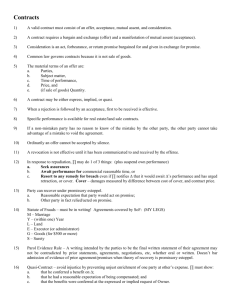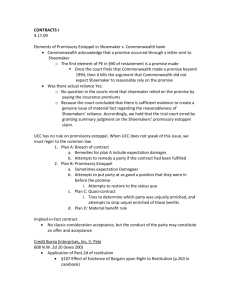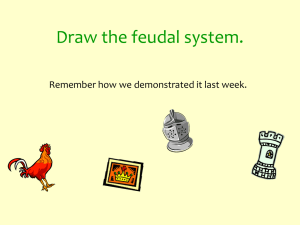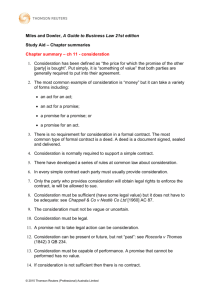Document
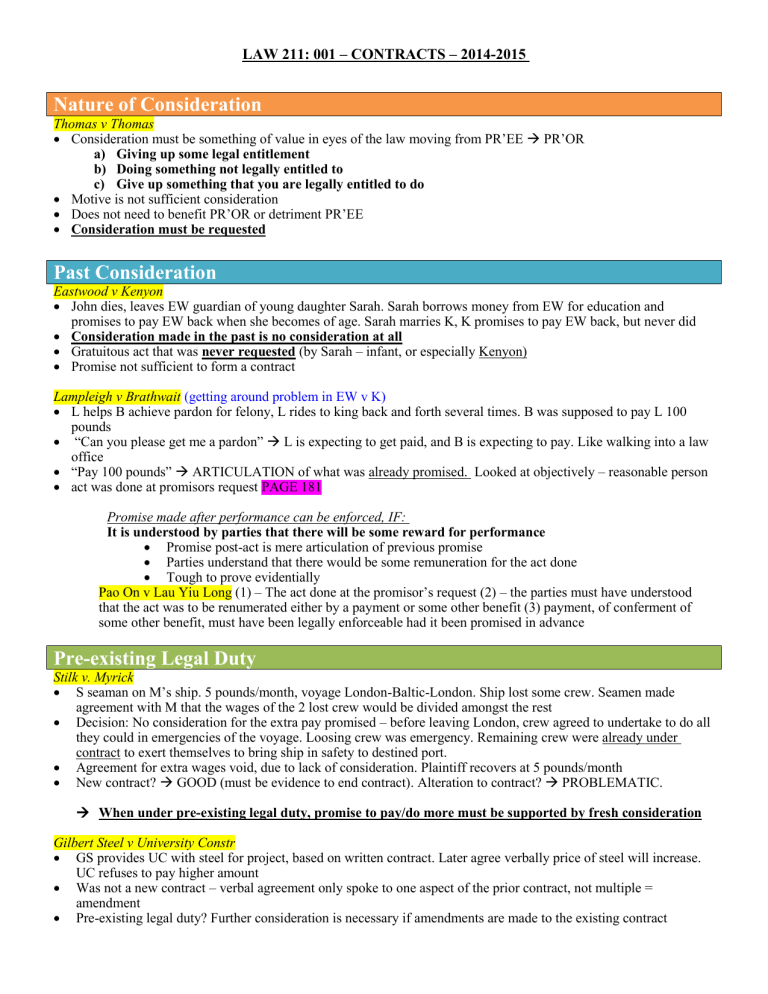
LAW 211: 001 – CONTRACTS – 2014-2015
Nature of Consideration
Thomas v Thomas
Consideration must be something of value in eyes of the law moving from PR’EE PR’OR a) Giving up some legal entitlement b) Doing something not legally entitled to c) Give up something that you are legally entitled to do
Motive is not sufficient consideration
Does not need to benefit PR’OR or detriment PR’EE
Consideration must be requested
Nature of Consideration
Past Consideration
Eastwood v Kenyon
John dies, leaves EW guardian of young daughter Sarah. Sarah borrows money from EW for education and promises to pay EW back when she becomes of age. Sarah marries K, K promises to pay EW back, but never did
Consideration made in the past is no consideration at all
Gratuitous act that was never requested
Promise not sufficient to form a contract
(by Sarah – infant, or especially Kenyon)
Lampleigh v Brathwait (getting around problem in EW v K)
L helps B achieve pardon for felony, L rides to king back and forth several times. B was supposed to pay L 100
pounds
“Can you please get me a pardon”
L is expecting to get paid, and B is expecting to pay. Like walking into a law office
“Pay 100 pounds”
ARTICULATION of what was already promised. Looked at objectively – reasonable person act was done at promisors request PAGE 181
Promise made after performance can be enforced, IF:
It is understood by parties that there will be some reward for performance
Promise post-act is mere articulation of previous promise
Parties understand that there would be some remuneration for the act done
Tough to prove evidentially
Pao On v Lau Yiu Long (1) – The act done at the promisor’s request (2) – the parties must have understood that the act was to be renumerated either by a payment or some other benefit (3) payment, of conferment of some other benefit, must have been legally enforceable had it been promised in advance
Pre-existing Legal Duty
Stilk v. Myrick
S seaman on M’s ship. 5 pounds/month, voyage London-Baltic-London. Ship lost some crew. Seamen made agreement with M that the wages of the 2 lost crew would be divided amongst the rest
Decision: No consideration for the extra pay promised – before leaving London, crew agreed to undertake to do all they could in emergencies of the voyage. Loosing crew was emergency. Remaining crew were already under contract to exert themselves to bring ship in safety to destined port.
Agreement for extra wages void, due to lack of consideration. Plaintiff recovers at 5 pounds/month
New contract?
GOOD (must be evidence to end contract). Alteration to contract?
PROBLEMATIC.
When under pre-existing legal duty, promise to pay/do more must be supported by fresh consideration
Gilbert Steel v University Constr
GS provides UC with steel for project, based on written contract. Later agree verbally price of steel will increase.
UC refuses to pay higher amount
Was not a new contract – verbal agreement only spoke to one aspect of the prior contract, not multiple = amendment
Pre-existing legal duty? Further consideration is necessary if amendments are made to the existing contract
1
st
Route to get around consideration
-2-
Practical Benefit + No Economic Duress
Williams v Roffey Bros. & Nicholls (departing from rigidity of Stilk + Myrick)
W employed by RB. W suffers financial difficulties, impedes on ability to complete project. RB facing penalty
clause if project not completed on time. RB offers W more money to complete project. RB refuses to pay, W sues.
Was the promise to pay additional money supported by consideration?
YES: PRACTICAL BENEFIT + NO
DURESS
Practical benefit : RB facing limitation date, easier to pay W more money than secure new contractor. Avoid hassle of suing W to complete work. 10,300 extra pounds is cheap compared to what they would have had to pay
No Duress : W was a screw up, incompetent – not manipulative, did not try to extract money. RB offered the additional money (USE DOCTRINE IN NAV CAN)
Greater Fredericton Airport Authority v. Nav Canada (Nav Can brings William/Roffy into Can. Law – but nav can looses)
NavCan says GFA needs new system. ASF agreement states NavCan runs navigation services, and pays for whatever equipment they need. NavCan refuses to pay for new system. Eventually GFA promises to pay. NavCan sues GFA for this promise.
Is the practical benefit enough to support GFA’s promise to pay for the new equipment?
NO
Nav can took advantage of external pressure faced by GFA = ECONOMIC DURESS (distinguishing
Williams/Roffy)
NavCan: “Unless you pay for equipment, we are stopping services” VS. RB: “we want you to finish, will pay $”
It would be unfair to enforce a promise that is extracted under undue pressure. Duress undermines intention.
Not a negative promise, so promissory estoppel does not apply
DOCTRINE OF ECONOMIC DURESS :
1.
Exertion of pressure by PR’EE (Williams did not exert pressure, it was the penalty clause – Williams did not ask for money, Williams was not at fault in a moral way)
2.
No practical alternative but to capitulate
3.
Combination of these factors lead to conclusion of no acquiescence Was consent vitiated?
GFA: immediately retracts deal, states they did not consent
Pressure is part of business, and take advantage of pressure – we don’t always call this duress.
Capitalism can be cruel. 1+2 are necessary but not sufficient – it is POSSIBLE to have 1 + 2, but both parties still consent.
*****in NAVCAN – no acquiescence*****
Foakes v Beer (overruled)
B lends F 2090 pounds, original promise incl. interest. B promises F: you don’t have to pay interest if you pay part of the debt. F pays part of the debt (500 pounds). B sues for interest.
Payment of a lesser amount cannot serve as satisfaction of a larger amount
Part payment cannot be consideration for a new promise
-3-
2
nd
Route
Promissory Estoppel
Central London Property v High Trees House
HT leases block of flats from CLP for 2500 pounds/year. War + heavy bombing of London = low occupancy rates.
Jan of 1940 – parties agree in writing to reduce rent by half, but not stipulated how long lower payment would apply
For 5 years, HT pays lower rent, flats began to fill 1945: back at full occupancy
CLP sues for full rental costs June 1945 onwards. Judgement for CLP in amount requested
CLP waived their strict legal rights for the period of the war
PROMISSORY ESTOPPEL: (1) Promise intended to be binding and acted upon, & (2) was PR’EE (whoever is asking for assistance of equity) acting equitably themselves?
o Applicable in “negative” promises: PR’OR saying, “you don’t have to do something” (you don’t have to pay the full rent)
John Burrows v Subsurface Surveys
JB agrees to sell all of the shares in his company to Whitcomb’s company, SS. JB + WC were friends – WC was late on a few payments, JB took no action. Relationship soured, JB demanded full $42,000 – as contract stipulated he could.
Did JB waive his strict legal rights under the contract by not taking action on the first few times WC was late paying? NO
1.
A friendly gesture is not a binding agreement;
If relied upon, estoppel will not be available as defence against strict legal rights
Facts here to indicate the parties had a previous relationship, not just commercial transaction
2.
For Estoppel to apply, JB’s conduct must amount to a promise or assurance intended to alter the legal relationship
D & C Builders v Rees
Rees was a shop owner that had work done on his shop by D&C. D&C submitted a bill for 746 pounds. Rees paid
250 and rc’vd discount of 14, debt=482. D&C made effort to collect money but Rees did not pay. D&C were in financial trouble and needed money. Mrs. Rees knew this, and offered 300 to satisfy the debt of 482. D&C said no, but Mrs. Rees said 300 or nothing. D&C had to accept, or they would have gone bankrupt. D&C signed saying it
“satisfied the debt”. D&C sues for remaining balance
Substitute agreements can be valid in equity, even if there is no consideration, if it would in inequitable to allow the creditor to sue for the money from the original contract
PROMISSORY ESTOPPEL :
1.
Agreement intended to be binding
2.
the debtor must have relied upon it, and
3.
it must have been unfair to allow the creditor to claim more money. is this an expansion of the test in
High Trees?
(1) promise intended to be binding (high trees) (2) PR’EE was not taking advantage of PR’OR(D&C) (3)
whether PR’EE relied on promise to such a degree that it would be inequitable to not enforce the promise
Pr. Estoppel not applicable: pressure placed on D&C by Rees forced them to accept an unsatisfactory agreement o Goes to the third requirement it would therefore NOT be inequitable to allow the creditor to claim full amount
WJ Alan
WJ sells coffee beans to El Nasr. At time of contract, Kenyan shillings=pound sterling in value. Contract in
KShills, but credit account in Pounds. Other descrepancies in contract, they were corrected. But still said pounds.
WJ accepts 1 st payment, 57,000 pounds. Then value of pound drops dramatically. WJ now wants payment in
KShills.
WJ trying to re-assert strict rules of contract: EN raised P.E. shield by accepting payment in pounds and redrafting credit statement w/o changing currency there was an implied promise they would not revert to KShills.
WJ argues EL did not act to detriment in reliance of the promise EL had gained a benefit
The Court:
-4- o COMMERCIAL TRANSACTION : not a friendly indulgent. Once alternative method of payment accepted, it is deemed to have been accepted as a term of the contract and the sellers waived their rights to be paid in KShills. o Detrimental reliance not required for P.E. to apply. (what would be detrimental is enforcing strict rules) o P.E. requires the claiming party relied on the actions of the other party and altered their position as a result
The Post Chaser
Palm&Vegetable Oils sold Malayan palm oil to Societe Italo-Belge, who sold it to Conti. Under contract, sellers were to give notice to the buyers of the ship’s sailing “in writing as soon as possible after vessels sailing”. Palm was a month late giving the notice to the buyer. Because of the breach, Societe could have rejected the shipment but they made no protest to the lateness of the notice. Societe asked Palm to send notice direct to Conti (jan 20).
Conti informed Societe that they were rejecting the documents as being out of time (Jan 22). Palm had to sell on open market, loosing 792.50/ton. Palm oil sues Societe.
Did Societie waive their right to reject sellers tender of documents? YES
Did Palm Oil rely on this representation? NO o Reliance could not have occurred within two days o Therefore, it would not be inequitable to enforce strict rules
PROMISSORY ESTOPPEL: Used as a shield, defending against enforcement of strict legal rights under contract
Petridis v Shabinsky
P leases restaurant space from S. To renew, P must provide notice to S before Dec. 31. P speaks to S before Dec
31, S says “lets negotiate in January” Waiver. They negotiate for a few months (continuance of waiver). Then, S decides he doesn’t was P to renew and says P’s open to renew expired months ago.
Promissory Estoppel applies: S waived rights (promise), P relied on waiver (promise).
Promissory Estoppel can be used as a cause of action who decides to bring action is not fundamental to the use of PE
Robichaud v Caisse populaire
CP has judgment over R for 3788.80. They enter agreement for 1000 to satisfy the debt. R gives CP cheque. CP later decides not to ratify the agreement, and does not cash the 1000 cheque. R brings action against CP to have the agreement upheld and the CP’s additional judgment against him struck out. R asserts P.E.
P.E applicable CP and R made agreement, and R relied on CP’s promise to his detriment o Full knowledge + no duress
PROMISSORY ESTOPPEL: Can be used as a cause of action, when P is trying to prevent enforcement of strict legal rights under a prior contract
Combe v Combe (leading case on sword/shield)
Mr. C agrees to pay Ms. C 100 pounds/year after they split up. Ms. C says she agreed to forego her rights for recovery in divorce court because of this. Husband does not pay.
Court found no consideration because Mr. C did not REQUEST that she forego her rights in divorce court
Wife claims Estoppel: Husband estopped from ceasing his promise, because she relied on his promise by refusing to take action in court
The Court: Estoppel does not apply. Ms. Combe is trying to enforce a POSITIVE PROMISE. Only issue is whether there is consideration (no consideration here because no request).
AUSTRALIA: Waltons Stores v Maher (Promissory estoppel as a sword forcing someone to keep promise)
W agreed to lease property that M owns. M demolishes buildings on property for the purpose of the lease. W knows that this is happening, and they know that they are not going to go ahead with the lease. They don’t tell M until demolishing has occurred.
Why resort to P.E? NO CONSIDERATION. Demolishing is legal detriment, but it wasn’t requested (as per facts)
M wants to use P.E. to force W to go ahead with lease (positive promise) o M relied on W’s promise to their detriment o General terms: any kind of non-contractual promise with no pre-existing legal relationship
Equity will come to the relief of a plaintiff who has acted in detriment, when the other party has played such a part in the adoption of the belief, that it would be unconscionable to not enforce the promise
-5-
Mere reliance does not bring P.E. into play. Must be UNCONSCIONABLE to not enforce
UNCONSCIONABILTY : acting more committed than you really are and leading the other party down the garden path. Transparency – if you are not sure, then you must say you are not sure. If you are not sure, but you say you
ARE sure, you are held to that. Pulling out after leading other party to believe it was a done deal. Evidence in this case suggests that all along, W did not think it was a done deal. Encouraging and inducing a false belief on the other party…
BCCA holds this case to “a promise to enter a contract”
Bakan thinks this principle reads more broadly. Reliance can be in and of itself enough to enforce a contract, even when lacking consideration
M(N) v. A (AT) (BCCA decision – takes narrowest possible interpretation of Waltons)
M promizes A he will pay the balance of her mortgage in England if she moves to Canada. She moves to Canada, but then he refuses to pay mortgage and kicks her out. A sues and claims estoppel (she relied and acted upon his promise)
Tried to have estoppel recognized an a cause of action to ENFORCE a positive promise
Court rejects this; says estoppel is only a shield o Further, no intentions of a legal relationship – so there was never a binding agreement o Walton’s only applies in situations where there is a promise to enter in legal relations
Privity: Third-Party Beneficiaries
The Rule
Provendor (son) v. Wood (reversed in Tweddle v Atkinson) Would we ever speak to this case on an exam?
W agreed with Provender’s father to pay 20 pounds to Provender(son) after Provender(son) and W’s daughter were married. W did not pay. Provender (son) brought action.
Decision for Provender(son): the party whom the benefit of a promise acrews may bring his action
William Tweedle (son)v Atkinson
John Tweddle (father of William Tweddle) makes agreement with Guy: if he pays WT 100, then Guy pay WT
Tweddle 200 after WT marries Guy’s daughter. Guy never paid. Guy dies. William Tweddle (son) sues Guy’s estate (through Atkinson – Executor)
No stranger to the consideration can take action, even if it was for his benefit
Natural love from the marriage is not sufficient consideration (not value in eyes of the law)
Monterous proposition if someone could sue under a contract but not by sued under it.
3 rd parties to a contract do not derive any rights from contract nor are they subject to any burdens imposed by it
Dunlop Pneumatic Tyre v Selfridge's
Dunlop sold tires to the wholesaler Dew and Company, on the terms that Dew would not sell tires below Dunlop’s list price.
Selfridge’s bought tires from Dew and signed contract that they would not sell tires below list price, and if they did they would pay
5 l to Dunlop for each sold. Selfridge’s sold two tires below list price and Dunlop brought action for injunction and damages.
Ratio – Only a person who is a party to a contract can sue on it (unless one of the parties is acting as an agent for the person who wishes to sue).
Beswick v Beswick (CA)
Beswick v Beswick (HL)
Peter Beswick (deceased) owned a coal business. He entered into an agreement transferring business to Joseph (his nephew). The agreement also said that Peter would be employed as consultant for the rest of his life and that Joseph would pay Peter’s widow
5 l /week after Peter died. Joseph only paid the widow once and then stopped. The widow sued Joseph as administratrix of Peter’s estate.
Issue – Can the widow sue as a third-party beneficiary or as administratrix?
Holding – The widow can sue as administratrix of Peter’s estate.
Ratio – The estate of a promisee can sue a promisor, but the third-party beneficiary cannot sue.
-6- ii) The Exceptions
Invoking exception to avoid being sued by invoking limitation of liability clause, warehouse men defending being sued by London drugs – NEGATIVE PROMISES – we don’t have a case where an exception is invoked regarding a POSITIVE PROMISE – but the court never says that the exceptions are limited to negative promise
(except can-dive)
a. Trust
Vandepitte v Preferred Accident
Preferred Accident, who promised to ensure any operator of the car who R.E. Berry gave permission to drive, insured R.E. Berry.
R.E. Berry gave Jean Berry permission to drive the car. Jean Berry got in an accident an injured Vandepitte, who sued Preferred
Accident after Jean Berry did not pay her judgment.
Holding – Jean Berry was not covered by insurance; the clause in the contract was merely a promissory representation and not binding in law or equity.
Ratio
–
An intention to create a trust must be proven (it cannot be inferred from general words of a policy).
For a contract to arise, there must be intention to conclude a contract.
Note – This case was overruled by legislation (s 24 of the Insurance Act ).
b. Agency
New Zealand Shipping v Satterthwaite
Ajax Machine Took Co manufactured and sold drill to SW. SW has drill shipped by Federal Steam Navigation, contract with them limits liability (claims must be within one year). SW brings action 3 years after damage to drill.
Limited liability applies to NZ, Federal Steam acting as agent for NZ.
Test for Agency
1 Party is meant to be covered by provisions; Stevedores don’t know who they are unloading for. But this is the norm for shipping company. Unilateral contract
2 Promissee is clearly acting as agent for the party; and
3 Promissee has authority to do this;
4 Any difficulties concerning consideration moving from the parties are null
**analogical jump to go from negative promise, to positive promise
Employment
London Drugs v Kuehne & Nagel (1992)
LD delivers transformer to K+N for storage. 2 K+N employees damage machine, causing $33k damage. Contract –
“warehouseman’s liability limited to $40”
IMPLICIT, identity between the company (artificial person) and the employees (arms+legs). Does limited liability extend to the employees? LD
K+N
employees (employee contract).
Employees are not part of contract with LD; LD tries to sue employees based on privity of contract. Employees covered by lmt liability. Intentions, expectations, and commercial reality/fairness.
Test for Employee Exclusion from Liability
1.
Limitation of liability clause must, either expressly or implied, extend its benefit to the employee(s) seeking to rely on it, and
2.
Employees must have been acting in the course of their employment and must have been performing the very services provided for in the contract between their employer and the other contracting party when the loss occurred
Edgeworth Construction v. N.D. Lea
Edgeworth won a bid to build a section of the highway and entered into contract with the province for the work. Edgeworth alleges that they lost money on the project due to errors in the specifications, which were prepared by N.D. Lea. Edgeworth sued N.D. Lea in negligence.
When a third party is not explicitly mentioned in an exclusion of liability clause, and the protection is not intended for their benefit, the third party is not protected.
N.D. Lea could and should have taken measures to protect itself.
Subrogation
Fraser River Pile and Dredge v. Can-Dive Services
Very plausible to read the case as one that says in basically every situation, this exception would be available
-7-
Where the contract intends to protect a third party, they will be protected
Comfortable – purely defensive use (as London Drugs) – but not definitive. The way the principle is built in is not a hard stop to offensive actions – but definitely a limitation. Other side will argue that exceptions to doctrine of privity are permitted in a defensive way
TEST – to circumvent doctrine of privity
1.
Did the parties intend to extend benefit to the third party?
2.
Are the activities performed by the third party the activities prescribed by the contract?
